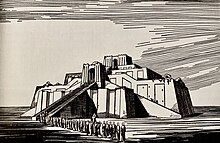Ziggurat of Ur
Etemenniguru | |
Dhi Qar Province, Iraq | |
| Region | Mesopotamia |
|---|---|
| Coordinates | 30°57′46″N 46°6′11″E / 30.96278°N 46.10306°E |
| Type | Temple |
| Part of | Ur |
| Area | 2880 m2[1] |
| Height | over 30 m[2] |
| History | |
| Builder | Ur-Nammu |
| Material | mud brick with burnt brick facing[2] |
| Founded | started in c. 2050–2030 BC, completed in c. 2030–1980 BC[2] |
The Ziggurat (or Great Ziggurat) of Ur (
Its remains were excavated in the 1920s and 1930s by Sir Leonard Woolley. Under Saddam Hussein in the 1980s, they were encased by a partial reconstruction of the façade and the monumental staircase. The Ziggurat of Ur is the best-preserved of those known from Mesopotamia, besides the ziggurat of Dur Untash (Chogha Zanbil).[5] It is one of three well-preserved structures of the Neo-Sumerian city of Ur, along with the Royal Mausolea and the Palace of Ur-Nammu (the E-hursag).
Sumerian ziggurat

The
measured 64 m (210 ft) in length, 45 m (148 ft) in width and over 30 m (98 ft) in height. The height is speculative, as only the foundations of the Sumerian ziggurat have survived.The ziggurat was a piece in a temple complex that served as an administrative center for the city, and which was a shrine of the moon god Nanna, the patron deity of Ur.[6]
The construction of the ziggurat was finished in the 21st century BC by King Shulgi, who, in order to win the allegiance of cities, proclaimed himself a god. During his 48-year reign, the city of Ur grew to be the capital of a state controlling much of Mesopotamia.
Neo-Babylonian restoration
King
Excavation and preservation
The remains of the ziggurat were rediscovered by William Loftus in 1850.[8] The first excavations at the site were conducted by John George Taylor (mistakenly credited as "J. E. Taylor")[9] in the 1850s, leading to the identification of the site as Ur. After World War I, preliminary excavations were performed by Reginald Campbell Thompson and Henry Hall. The site was extensively excavated in the 1920s by Sir Leonard Woolley by appointment of the University Museum of the University of Pennsylvania and the British Museum in the period of 1922 to 1934.
The remains of the ziggurat consist of a three-layered solid mass of mud brick faced with burnt bricks set in bitumen. The lowest layer corresponds to the original construction of Ur-Nammu, while the two upper layers are part of the Neo-Babylonian restorations.[10] The façade of the lowest level and the monumental staircase were rebuilt under the orders of Saddam Hussein.[11]
The ziggurat was damaged in the Gulf War in 1991 by small arms fire, and the structure was shaken by explosions.[12] Four bomb craters can be seen nearby, and the walls of the ziggurat are marred by over 400 bullet holes.[13]

As of 2008, the site was under the supervision of curator Dief Mohssein Naiif al-Gizzy.[14]
Gallery
-
U.S. Soldiers from the 17th Fires Brigade make their way up the reconstructed stairs of the Ziggurat of Ur, 2010.
See also
- Abraham
- Nasiriyah Airport
- Abraham and the temple in Islamic tradition
- Ennigaldi-Nanna's museum
- Architecture of Mesopotamia
- Ur of the Chaldees
- Ziggurat of Aqar Quf
References
- ISBN 978-1-78274-748-2.
- ^ ISBN 978-1-78274-748-2.
- ISBN 978-965-226-018-5.
- ^ a b "The Ziggurat of Ur". British Museum. Retrieved 24 November 2017.
- ISBN 9783110085310.
- ISBN 9780155050907.
- ISBN 9781884964039.
- ^ Boulger, George Simonds (1893). . In Lee, Sidney (ed.). Dictionary of National Biography. Vol. 34. London: Smith, Elder & Co. pp. 80–81.
- S2CID 131633828.
- ^ Woolley, C. Leonard (1972) [1939]. The Ziggurat and its Surroundings. Ur Excavations. Vol. 5. Trustees of the Two Museums.
- ^ Marozzi, Justin (8 August 2016). "Lost cities #1: Babylon – how war almost erased 'mankind's greatest heritage site'". The Guardian. Retrieved 24 November 2017.
- National Geographic News. Archived from the originalon 24 March 2003. Retrieved 25 June 2023.
- ISBN 9781591020967.
- ZUMA Press. 1 March 2008. Retrieved 24 November 2017.
Further reading
- Woolley, C. Leonard and Moorey, P. R. S., Ur of the Chaldees: Revised and Updated Edition of Sir Leonard Woolley's Excavations at Ur, Cornell University Press (1982).
External links
- Ziggurat of Ur Archived 27 October 2014 at the Wayback Machine, Smarthistory at Khan Academy
- Ur (modern name: Tell el-Muqayyar) at Open Context
- A brief history of the Sumerian Ziggurat at Ur
- Archaeology of ancient Iraq with a section on the ziggurat






